
► Site d'observation, la minoterie des Monards
L'ancienne minoterie des Monards enjambe la rivière de Chauvignac qui se jette ensuite dans le chenal du port puis dans l'estuaire de la Gironde.
Ce moulin à farine a pendant longtemps utilisé la force de l'eau pour faire tourner les roues activant les meules chargées de réduire le grain de blé en farine.
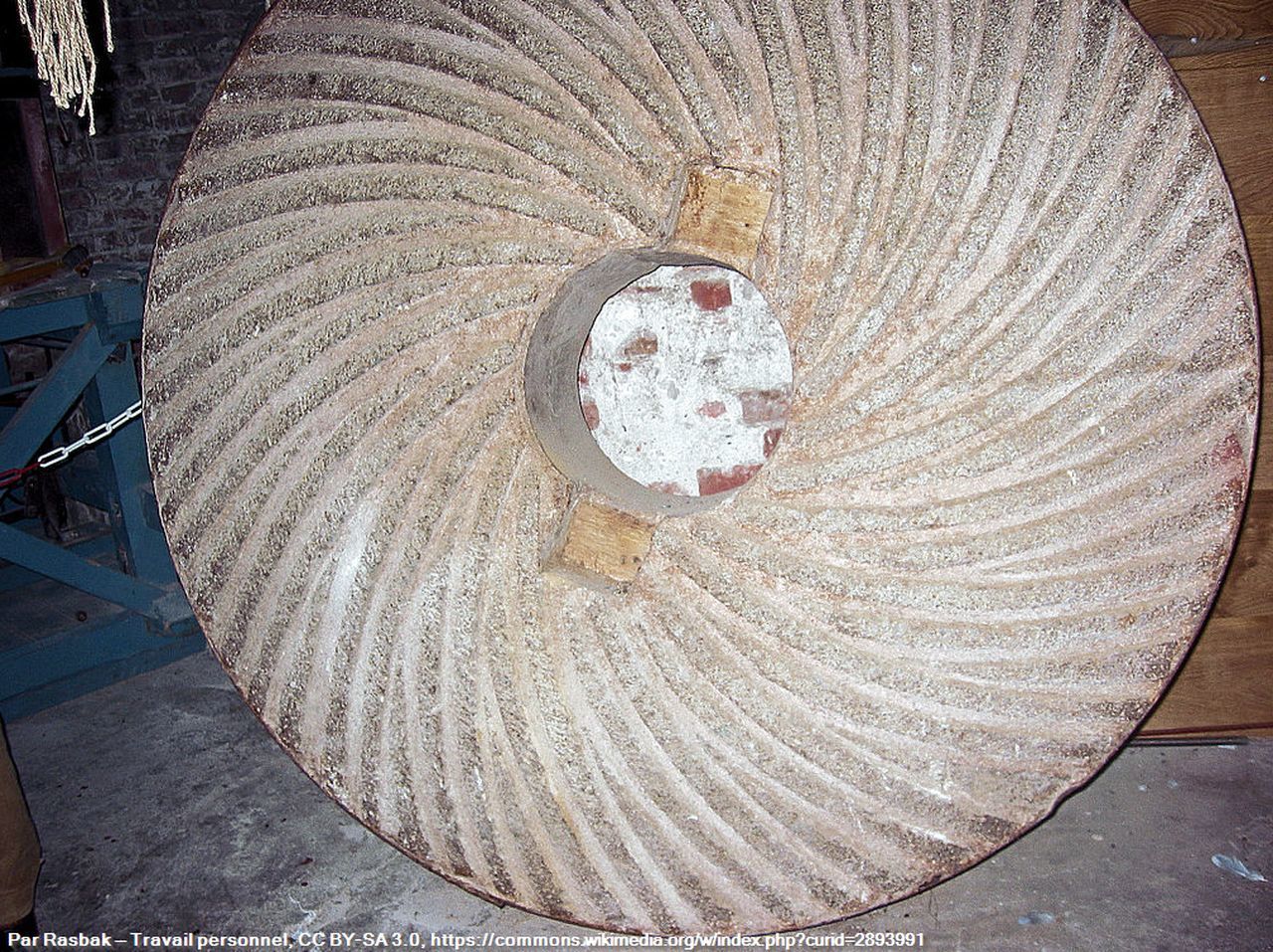
► Critères de choix d'une pierre à meules
Au fil des âges s'est précisée la définition d'un bonne pierre à meules ; c'est celle qui possède trois caractéristiques fondamentales :
- Une insensibilité à l’altération, qu’il s’agisse d’une dissolution (gypse), de l’action de l’humidité (cas du calcaire) ou chimique sous l’action de l’eau (altération des micas ou présence de fer).
- Une hétérogénéité à l’échelle millimétrique et centimétrique pour avoir des aspérités qui écrasent et des canaux qui évacuent.
- Une porosité importante qui facilite le travail de la meule et l’exploitation en carrière.
Par ailleurs, une très bonne roche meulière est en général riche en silice : plus le pourcentage est élevé et plus la roche est résistante.
Ainsi, le quartz, formé de silice pur (SiO2), est un des matériaux de référence dans l'échelle de dureté des roches, l'échelle de Mohs.
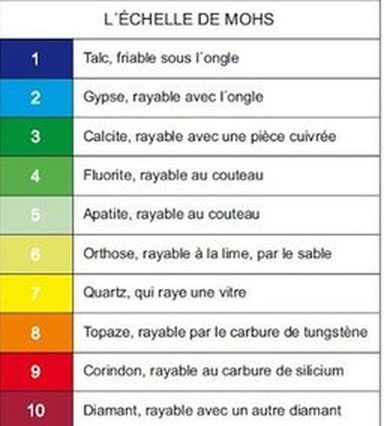
► Quelques roches à meules
~ Le grès jaune calcaire microconglomératique
Les grès sont des roches détritiques issues de la diagenèse de fragments d'autres roches (clastes) pris dans un ciment.
Selon la taille des grains, quand ceux-ci sont relativement gros (quelques millimètres), le grès prend alors le qualificatif de microconglomératique.
Le ciment des grès jaunes sont généralement calcaire ; il est même parfois possible de trouver des fragments de fossiles dans cette matrice.

Ces roches gréseuses à ciment calcaire possèdent une porosité moyenne (11%), une granulométrie souvent grossière et un pourcentage de silice variable (40 à 50%).
~ Le grès rose (grès siliceux)
Le grès de Vosges est également une roche sédimentaire détritique. Il s'agit d'une roche cohérente et dure et avec une porosité moyenne (11%).
C'est une roche composée de grains de quartz assez fins (de l'ordre du millimètre) avec une matrice elle aussi composée de silice, d'ou son nom de grès siliceux (80% à 90% de silice).
La roche prend des couleurs différentes en fonction de la présence d'oxyde de fer. Ce phénomène de colorisation, appelé aussi rubéfaction, est dû à l’altération de minéraux riches en fer qui en se décomposant libèrent leur fer qui migre vers les grains voisins et habille ceux-ci d’une fine pellicule rose. Cette présence de fer peuvent poser des problèmes dans son utilisation en meunerie.
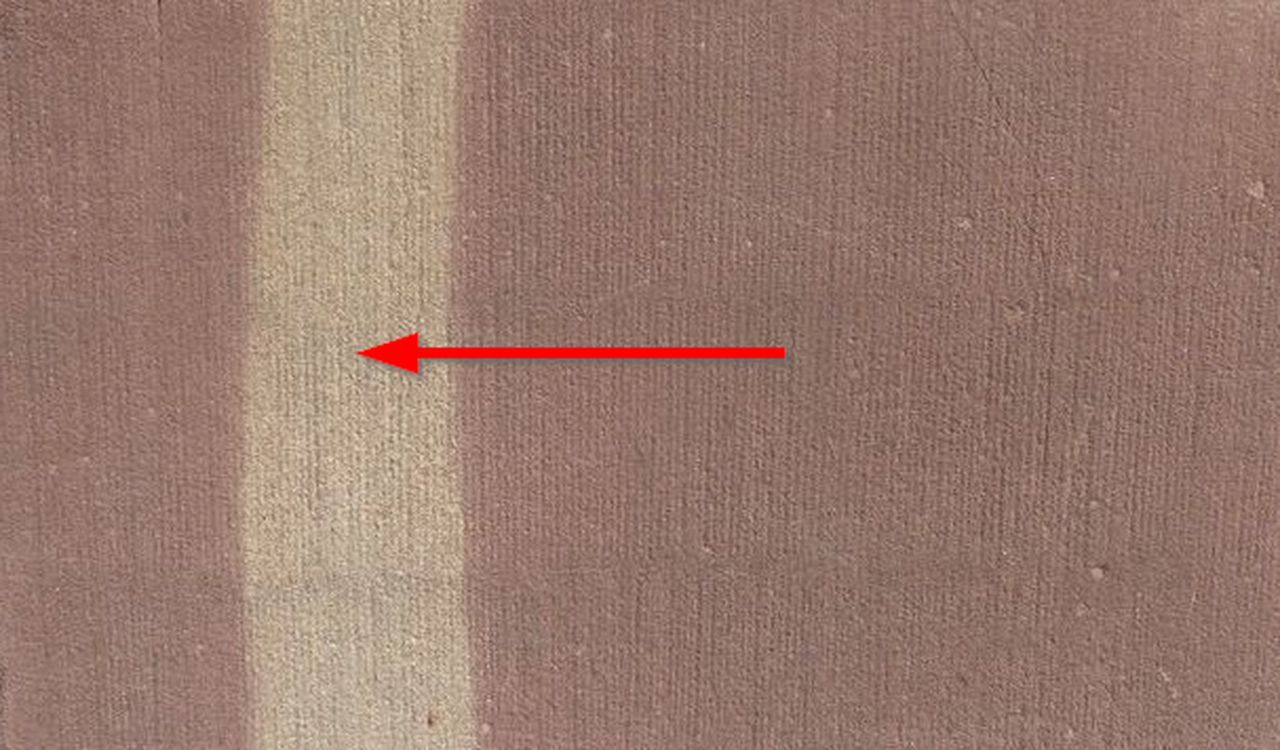
~ Le granite
Le granite est une roche cristalline plutonique magmatique qui se forme en profondeur par refroidissement très lent du magma.
Les minéraux cristallisent alors dans un certain ordre : d'abord les micas noirs, puis les feldspaths blancs opaques, enfin les quartz, cristaux de silice translucide de couleur gris.
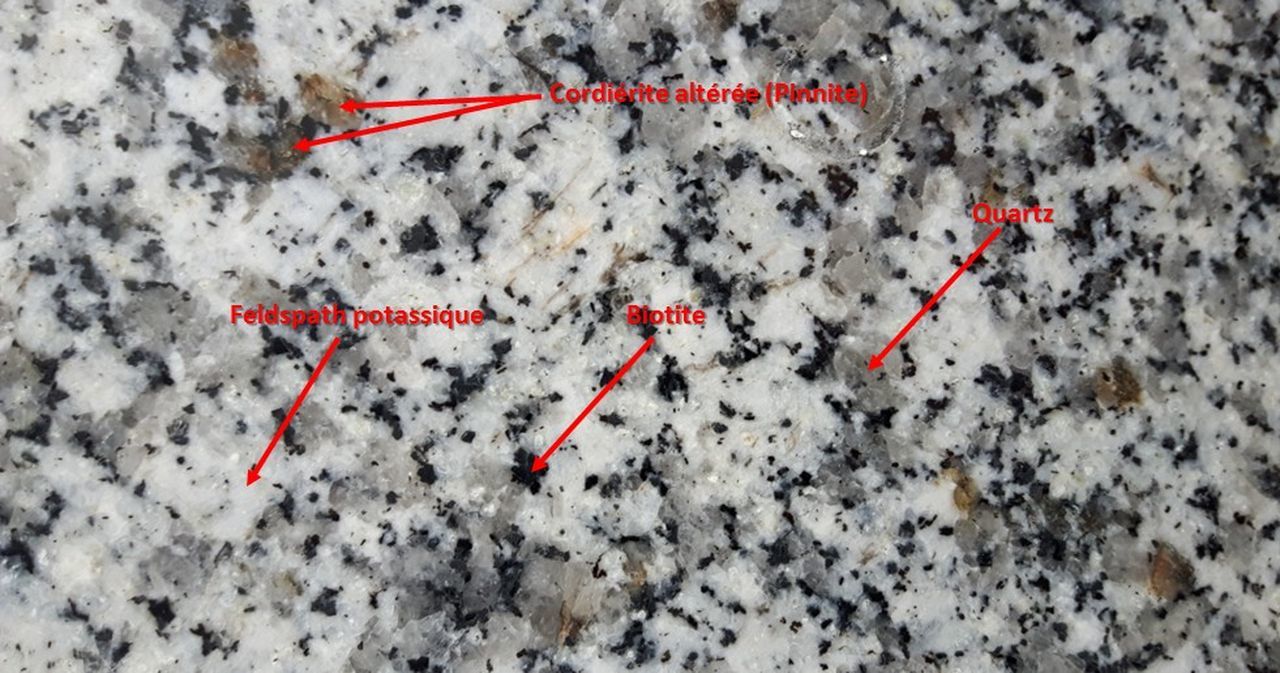
Le granite est une roche à texture grenue (nombreuses aspérités), cette texture étant à l'origine de son nom dérivé du latin granum, grain. C'est également une roche dense (densité moyenne : 2,7) et très dure du fait de sa richesse en silice.
Elle est en revanche très peu poreuse (très difficile à travailler), et la présence de mica noir peut poser des soucis (altération rapidement en donnant des oxydes de fer).
~ La pierre meulière
La pierre meulière, ou meulière, est une roche sédimentaire siliceuse (ou roche siliceuse) de couleur grise ou blanche.
Elle résulte de la silicification irrégulière de calcaires ou de marnes lacustres, en masses irrégulières, arrondies ou anguleuses, massives et homogènes ou d'aspect bréchique.
Cette évolution géochimique complexe (appelée meuliérisation) lors d'une phase de continentalisation, proviendrait de la désilicification des argiles lors des périodes d'assèchement du lac, associée à une silicification climatique des calcaires ou des marnes par dissolution du carbonate de calcium, ne laissant en place que la silice.
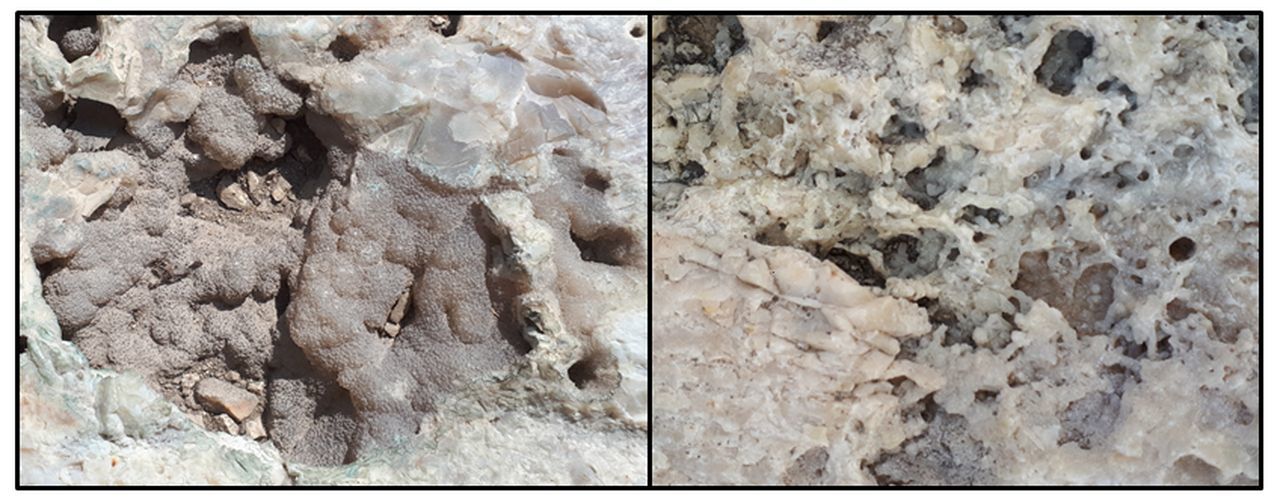
C'est une pierre à la fois extrêmement solide (98% de silice), insensible à l’altération de l’eau de pluie, imperméable et poreuse (15%).
C'est également une pierre avec une grande hétérogénéité de surface, lui donnant naturellement un grain assez grossier.
► Observation site, the flour mill of Monards
The former Monards flour mill spans the Chauvignac river, which then flows into the port channel and then into the Gironde estuary.
This flour mill has for a long time used the force of water to turn the wheels activating the millstones responsible for reducing the grain of wheat into flour.
► Criteria for choosing a grinding stone
Over the ages, the definition of a good grindstone has become clearer; it is one that has three fundamental characteristics:
- An insensitivity to alteration, whether it is a dissolution (gypsum), the action of humidity (case of limestone) or chemical under the action of water (alteration of micas or presence of iron).
- Heterogeneity on the millimeter and centimeter scales to have asperities which crush and channels which evacuate.
- A significant porosity which facilitates the work of the grinding wheel and the exploitation in quarry.
In addition, a very good millstone is generally rich in silica: the higher the percentage, the more resistant the rock.
Quartz, formed from pure silica (SiO2), is one of the reference materials in the rock hardness scale, the Mohs scale.
► Some grinding stones
~ The yellow microconglomeric limestone sandstone
Sandstones are detrital rocks resulting from the diagenesis of fragments of other rocks (clasts) caught in a cement.
Depending on the size of the grains, when they are relatively large (a few millimeters), the sandstone then takes the qualifier of microconglomeric.
The cement of yellow sandstones are generally calcareous; it is even sometimes possible to find fragments of fossils in this matrix.
These limestone cement sandstone rocks have an average porosity (11%), an often coarse particle size and a variable percentage of silica (40 to 50%).
~ Pink sandstone (siliceous sandstone)
Vosges sandstone is also a detrital sedimentary rock. It is a coherent and hard rock with an average porosity (11%).
It is a rock composed of fairly fine quartz grains (of the order of a millimeter) with a matrix also composed of silica, hence its name silica sandstone (80% to 90% silica).
The rock takes on different colors depending on the presence of iron oxide. This colorization phenomenon, also called reddening, is due to the alteration of iron-rich minerals which, when decomposed, release their iron which migrates to neighboring grains and dresses them in a thin pink film. This presence of iron can cause problems in its use in milling.
~ Granite
Granite is a plutonic magmatic crystalline rock which is formed in depth by very slow cooling of the magma.
The minerals then crystallize in a certain order: first the black micas, then the opaque white feldspars, finally the quartz, translucent gray silica crystals.
Granite is a rock with a grainy texture (many roughness), this texture being at the origin of its name derived from the Latin granum, grain. It is also a dense rock (average density: 2.7) and very hard because of its richness in silica.
It is however very porous (very difficult to work), and the presence of black mica can cause concerns (deterioration quickly by giving iron oxides).
~ The millstone
The millstone is a siliceous sedimentary rock (or siliceous rock) of gray or white color.
It results from the irregular silicification of limestones or lacustrine marls, in irregular masses, rounded or angular, massive and homogeneous or of brecciated appearance.
This complex geochemical evolution (called milling) during a phase of continentalization, would come from the desilicification of clays during periods of drying of the lake, associated with climatic silicification of limestones or marls by dissolution of calcium carbonate, leaving no in place as silica.
It is a stone that is both extremely solid (98% silica), insensitive to rainwater alteration, waterproof and porous (15%).
It is also a stone with a great heterogeneity of surface, naturally giving it a rather coarse grain.
► Sources bibliographiques / Bibliographical sources
Les Questions / The Questions
La lecture attentive du descriptif de la cache, ainsi qu'une observation des éléments de terrain et un peu de déduction sont normalement suffisants pour répondre aux questions de cette EarthCache.
A careful reading of the description of the cache, as well as observation of terrain features and some deduction is usually sufficient to answer questions of this EarthCache.
Questions pour valider :"Les Meules de Chauvignac"
Questions to validate: "Chauvignac millstones"
- Question 0 : Prenez une photo de vous ou d'un élément vous identifiant avec le site de l'ancienne minoterie des Monards en arrière plan (pas les meules).
Cette photo devra au choix nous être transmise avec les réponses ou être ajoutée à votre log.
-Question 0 : Take a photo of yourself or of an item identifying yourself with the site of the former Monards flour mill in the background (not the millstones).
This photo must either be sent to us with the answers or added to your log.
Point 1 : N 45° 30.981 W 000° 51.226
Vous voici devant 2 petites meules ; étudions celle de gauche en rouge (photo WP1).
Here you are in front of 2 small haystacks; let's study the left one (photo WP1).
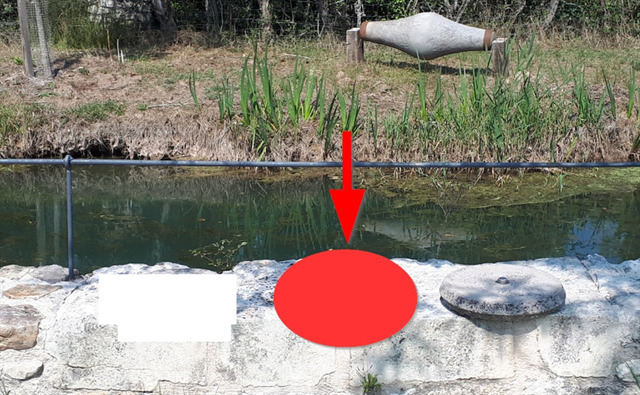
- Question 1 : Étudiez la roche de la meule (nature cristalline ou détritique, couleur, texture). Déduisez-en la nature de la roche. Vous pouvez observer une variation de couleur, à quoi est-elle due ? Essayez de rayer cette meule avec une lame en métal et déduisez-en sa dureté.
- Question 1 : Study the rock of the millstone (crystalline or detrital nature, color, texture). Deduce the nature of the rock. You can see a variation in color, what is it due to? Try to scratch this wheel with a metal blade and deduce its hardness.
Point 2 : N 45° 30.964 W 000° 51.242
- Question 2 : Étudiez la roche de la grosse meule sur l'herbe (nature cristalline ou détritique, couleur, texture). Déduisez-en la nature de la roche. Essayez de rayer cette meule avec une lame en métal et déduisez-en sa dureté.
- Question 2 : Study the rock of the big wheel on the grass (crystalline or detrital nature, color, texture). Deduce the nature of the rock. Try to scratch this wheel with a metal blade and deduce its hardness.
Point 3 : N 45° 30.971 W 000° 51.240
Vous voici face à deux grosses meules placées en hauteur ; placez vous de telle manière être entre le support des meules et le petit silo "minoterie", pour voir les deux meules à découvert (photo WP3).
You are facing two large grinding stones placed high up; place yourself in such a way as to be between the support of the millstones and the small "flour mill" silo, to see the two millstones uncovered (photo WP3).

- Question 3 : Étudiez la roche de la meule rouge de gauche (nature cristalline ou détritique, couleur, texture). Déduisez-en la nature de la roche. Essayez de rayer cette meule avec une lame en métal et déduisez-en sa dureté.
- Question 3 : Study the rock of red wheel on the left (crystalline or detrital nature, color, texture). Deduce the nature of the rock; Try to scratch this wheel with a metal blade and deduce its hardness?
- Question 4 : Étudiez la roche de la meule bleue de droite (nature cristalline ou détritique, couleur, texture). Déduisez-en la nature de la roche ; Essayez de rayer cette meule avec une lame en métal et déduisez-en sa dureté ?
- Question 4 : Study the rock of the right blue wheel (crystalline or detrital nature, color, texture). Deduce the nature of the rock; Try to scratch this wheel with a metal blade and deduce its hardness?
- Question 5 : Quel point géologique commun y a t-il entre les 4 meules ? Quel rapport avec leur dureté et leur utilisation dans la minoterie ?
- Question 5 : What common geological point is there between the 4 grinding stones? What does this have to do with their hardness and their use in the flour mill?
- Question 6 : En reprenant les critères physico-chimiques de choix d'une pierre à meules, décrire les avantages et/ou les inconvénient de chacune des pierres étudiées. A votre avis, quelle est la pierre la mieux adaptée comme meule à grains ?
- Question 6 : Using the physico-chemical criteria for choosing a millstone, describe the advantages and / or disadvantages of each of the stones studied. In your opinion, which stone is best suited as a grain mill?
Vous pouvez vous loguer sans attendre notre confirmation,
mais vous devez nous envoyer les réponses en même temps soit par mail via notre profil (
fafahakkai), soit via la messagerie geocaching.com (Message Center).
S'il y a des problèmes avec vos réponses nous vous en ferons part.
Les logs enregistrés sans réponses et la photo seront supprimés.
You can log this cache without waiting for our confirmation, but you must send us the answers at the same time, by e-mail via our profile (fafahakkai) or by the system of Message Center of geocaching.com.
If there is a problem with your answers we will notify you. The logs recorded without answers and the photo will be deleted.
Rappel concernant les « Earthcaches »: Il n'y a pas de conteneur à rechercher ni de logbook à renseigner. Il suffit de se rendre sur les lieux, de répondre aux questions ci-dessus et de nous renvoyer les réponses.
Reminder concerning "Earthcaches": there is neither a container to look for nor a logbook to sign. One need only go to the location, answer to the differents questions and send us the answers.